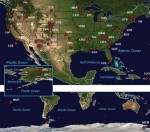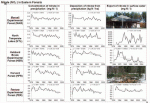Although it is widely recognized that the Earth's environment is changing, and that long-term data are needed to assess the rate and direction of change, to distinguish directional trends from short-term variability, and to forecast future responses, the accessibility of long-term data beyond the original user has historically been limited. The EcoTrends project, now nearing completion of an important step in its development, is a network-level resource that will allow cross-site and network-wide comparisons that are critical to addressing ecological problems relevant to the LTER Decadal Plan.
The EcoTrends Project started in 2004 as a casual conversation between Deb Peters (JRN) and Ariel Lugo (LUQ) about the need for easy access to many long-term data sets to allow cross-site comparisons. This conversation has resulted in the synthesis of more than 1000 datasets from 50 sites-LTER, the US Department of Agriculture (USDA)'s Agricultural Research Service (ARS), the USDA Forest Service, and other agencies (Fig. 1) that will be available soon on the EcoTrends website (www.ecotrends.info/EcoTrends). Many of these datasets will be included in a book to be submitted for publication in the next few months.
At the core of EcoTrends are two key aspects:
- A focus on derived data-complicated datasets are condensed into annually, monthly, or seasonally derived values
- Attribution to the original data source.
Both the book and the website will be invaluable as the LTER Network continues to develop network-level, synthetic research for the next decade. The project is funded through NSF supplements to Jornada and the LTER Network Office (LNO).
The EcoTrends book illustrates through detailed examples the value and importance of comparing long-term data (in most cases greater than 10 years) from different ecosystems (e.g., forests, grasslands, deserts, freshwater lakes and streams, near coastal marine and estuaries, urban, arctic and Antarctic). It demonstrates the power of a geographically-distributed network of sites in studying long-term phenomena on similar themes (e.g., response to climate and disturbances, patterns through time in biogeochemistry, biotic structure, and human populations). The book is designed to enable users to view patterns in data from many sites, and to easily understand the lessons learned from long-term data (Fig. 2). After a thorough analysis of publishers, the EcoTrends Editorial Committee decided to go with the USDA-ARS-a federal government agency that will promote wide distribution of the book by keeping the costs reasonable and allowing free downloads of its on-line version.
Upon completion the accompanying EcoTrends website will contain all of the derived data in the book and additional datasets with their associated metadata, along with links to the original data sources. Users will be able to search and query the database, create new graphs and combinations of variables, and save graphs and data locally. Future modifications, depending on funding, include the automatic harvesting of data to keep the database up-to-date, and the inclusion of more sites and datasets. Development of the web site has occurred primarily through efforts by Mark Servilla and Duane Costa at the LNO with input from the EcoTrends committee.
The success of this project depends heavily on an active Editorial Committee comprising Scott Collins (SEV), Charles Driscoll (HBR), Peter Groffman (HBR), Morgan Grove (BES), Tim Kratz (NTL), A. Lugo (LUQ), Mark Ohman (CCE), Deb Peters (JRN), and Bob Waide (LNO), interacting closely with the project coordinator Christine Laney (JRN), technical staff at the LNO (Servilla, Costa, James Brunt and Inigo San Gil); members of LTER committees (Ken Ramsey [IMEXEC], Don Henshaw and Wade Sheldon [NISAC], and Charlene d'Avanzo [Education]); site-based Information Managers and scientists; and collaborations with NCEAS (Mark Schildhauer). Chris Boone (BES), Ted Gragson (CWT) and Nicole Rosamilia compiled the human population and economy data for all 23 LTER sites where data were collected. These data currently reside on the Coweeta website (http://coweeta.ecology.uga.edu/trends/catalog_trends_base2.php), and are being incorporated into the EcoTrends website.
The next steps in the project are three-fold:
- First, we will continue to populate the EcoTrends database. To ensure the quality of the data, the lead Principal Investigator of each LTER site will be sent a file containing the derived data for their site. It will be the responsibility of each site to check the quality of their data prior to its publication and posting.
- Second, we plan to complete the text and figures for the book within the next few months. At that time, we will request reviews from within the network to ensure a high quality product.
- Finally, we will continue to promote EcoTrends to broader audiences. For example, the Ecological Society of America has endorsed the EcoTrends project and the two sites now provide links to each other's web pages.


 Enlarge this image
Enlarge this image
